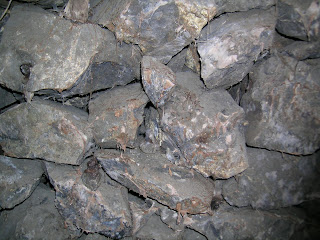Smallcleugh Mine from what I can gather was started in about 1770, looking for the continuation of Hanginshaw's West of Nent Vein, but this was soon abandoned. In 1787 the work was restarted by an agent for the London Lead Company along the Smallcleugh Cross Vein which produced an immense quantity of ore. There where also many other rich veins worked from Smallcleugh - Middlecleugh (and 1st and 2nd Sun Veins), Longcleugh, and Great Cross. The mine over the years was also worked by the Nenthead and Tynedale Lead and Zinc Company and Vieille Montagne Zinc Company. Most of the operations in Smallcleugh had come to an end around the 1900's. In 1963 the mine was briefly reopened in pursuit of new ore reserves, but little large scale mining took place. A famous occurrence at the mine was the dinner party held down it. On September 2nd 1901, 28 members of the local Masonic branch held a dinner down the mine in a large stope know today as the Ballroom Flat.
It is often assumed that Smallcleugh Mine extends all the way to Bogg Shaft and beyond, as these are reached via the Smallcleugh portal, however Smallcleugh originally only went as far as the Longcleugh Vein past the Ballroom, and the beginnings of the Middlecleugh Vein and Middlecleugh Second Sun Vein. The area past this which covers Carr's Cross Vein, Cow Hill Cross Vein, Barron's Sump Chamber and beyond are is in fact a separate mine called Longcleugh Mine, which was originally worked by shafts.
From Here We Srt'd down via prouds sump into Rampgill Horse Level. Started by the Greenwich Hospital in 1736 following the Scaleburn Moss Vein until it reached Fairhill Vein, this then followed into Rampgill Vein. Rampgill Vein may have been worked as early as 1690. There are references to other veins being worked from much earlier on which join into Rampgill Mine. In 1745 the lease was sold to the London Lead Company who developed the mine at an impressive rate and found the Rampgill Vein and others to be incredibly rich in ore. Altogether Rampgill with all its veins yielded 140,000 tons of lead ore between 1703 and 1886.
By the end of the 19th century most of Rampgill Vein above the water table had been worked out. Between 1899 and 1921 the Vieille Montagne Zinc Company reworked some of the veins in Rampgill Mine and Coalcleugh Mine for zinc ore, with the Rampgill Horse Level being used for access to Coalcleugh Mine. The Rampgill Horse Level was also used as a haulage way via the Hanginshaw Branch Level for the eastern workings of the Middlecleugh and Longcleugh Veins in Smallcleugh Mine.
One of major veins in Rampgill Mine, Scaleburn Vein is generally referred to as being part of Rampgill Mine, it is however a sperate mine in its own right and it only used the Rampgill portal as its access point.
It is often assumed that Smallcleugh Mine extends all the way to Bogg Shaft and beyond, as these are reached via the Smallcleugh portal, however Smallcleugh originally only went as far as the Longcleugh Vein past the Ballroom, and the beginnings of the Middlecleugh Vein and Middlecleugh Second Sun Vein. The area past this which covers Carr's Cross Vein, Cow Hill Cross Vein, Barron's Sump Chamber and beyond are is in fact a separate mine called Longcleugh Mine, which was originally worked by shafts.
From Here We Srt'd down via prouds sump into Rampgill Horse Level. Started by the Greenwich Hospital in 1736 following the Scaleburn Moss Vein until it reached Fairhill Vein, this then followed into Rampgill Vein. Rampgill Vein may have been worked as early as 1690. There are references to other veins being worked from much earlier on which join into Rampgill Mine. In 1745 the lease was sold to the London Lead Company who developed the mine at an impressive rate and found the Rampgill Vein and others to be incredibly rich in ore. Altogether Rampgill with all its veins yielded 140,000 tons of lead ore between 1703 and 1886.
By the end of the 19th century most of Rampgill Vein above the water table had been worked out. Between 1899 and 1921 the Vieille Montagne Zinc Company reworked some of the veins in Rampgill Mine and Coalcleugh Mine for zinc ore, with the Rampgill Horse Level being used for access to Coalcleugh Mine. The Rampgill Horse Level was also used as a haulage way via the Hanginshaw Branch Level for the eastern workings of the Middlecleugh and Longcleugh Veins in Smallcleugh Mine.
One of major veins in Rampgill Mine, Scaleburn Vein is generally referred to as being part of Rampgill Mine, it is however a sperate mine in its own right and it only used the Rampgill portal as its access point.
Tallow Candles
Left To Right: Richard V, Wayne M, Mike R, Me.




























No comments:
Post a Comment